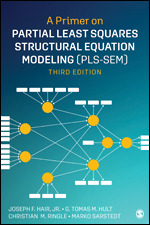Preface
About the Authors
Chapter 1. An Introduction to Structural Equation Modeling
What Is Structural Equation Modeling?
Considerations in Using Structural Equation Modeling
Principles of Structural Equation Modeling
PLS-SEM, CB-SEM, and Regressions Based on Sum Scores
Considerations When Applying PLS-SEM
Guidelines for Choosing Between PLS-SEM and CB-SEM
Organization of Remaining Chapters
Critical Thinking Questions
Chapter 2. Specifying the Path Model and Examining Data
Stage 1: Specifying the Structural Model
Stage 2: Specifying the Measurement Models
Stage 3: Data Collection and Examination
Case Study Illustration—Specifying the PLS-SEM Model
Critical Thinking Questions
Chapter 3. Path Model Estimation
Stage 4: Model Estimation and the PLS-SEM Algorithm
Case Study Illustration—PLS Path Model Estimation (Stage 4)
Critical Thinking Questions
Chapter 4. Assessing PLS-SEM Results—Part I: Evaluation of the Reflective Measurement Models
Overview of Stage 5: Evaluation of Measurement Models
Stage 5a: Assessing Results of Reflective Measurement Models
Case Study Illustration—Evaluation of the Reflective Measurement Models (Stage 5a)
Critical Thinking Questions
Chapter 5. Assessing PLS-SEM Results—Part II: Evaluation of the Formative Measurement Models
Stage 5b: Assessing Results of Formative Measurement Models
Case Study Illustration—Evaluation of the Formative Measurement Models (Stage 5b)
Critical Thinking Questions
Chapter 6. Assessing PLS-SEM Results—Part III: Evaluation of the Structural Model
Stage 6: Structural Model Results Evaluation
Case Study Illustration—Evaluation of the Structural Model (Stage 6)
Critical Thinking Questions
Chapter 7. Mediator and Moderator Analysis
Case Study Illustration—Moderation
Critical Thinking Questions
Chapter 8. Outlook on Advanced Methods
Importance-Performance Map Analysis
Necessary Condition Analysis
Confirmatory Tetrad Analysis
Treating Observed and Unobserved Heterogeneity
Measurement Model Invariance
Critical Thinking Questions
Glossary
References
Index

